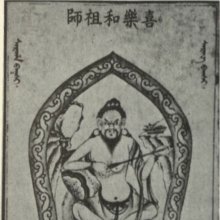Saraha, Sharaha: 7 definitions
Introduction:
Saraha means something in Buddhism, Pali, Hinduism, Sanskrit, Jainism, Prakrit, Hindi. If you want to know the exact meaning, history, etymology or English translation of this term then check out the descriptions on this page. Add your comment or reference to a book if you want to contribute to this summary article.
Alternative spellings of this word include Sharah.
Images (photo gallery)
In Buddhism
Tibetan Buddhism (Vajrayana or tantric Buddhism)
Source: Google Books: Mahāmudrā and Related InstructionsSaraha (सरह) is the name of an ancient teacher, according to “the succession of Gurus in the Mahāmudrā lineages” in the Kagyü School of Tibetan Buddhism (the Mahāmudrā deals with the nature of the mind).—According to the special Mantrayāna tradition, one lineage is: (1) Vajradhara, (2) Tilopa, (3) Nāropa, and (4) Marpa Lotsāwa. Another lineage is: (1) Vajradhara, (2) Matiratna, (3) Saraha, [(4) Nāgārjuna], (5) Śavaripa, (6) Maitripa, and (7) Marpa Chökyi Lodrö. Afterward, both lineages merge in Lord Milarepa, Lord Daö Shönu [i.e., Gampopa], and so on. This is the lineage of the Kamtsang [Kagyü]. [...]
Source: Wisdomlib Libary: VajrayanaSaraha is the name of a mahāsiddha, of which eighty-four in total are recognized in Vajrayāna (tantric buddhism). His title is “the great brahmin”. He lived somewhere between the 8th and the 12th century AD.
These mahāsiddhas (e.g., Saraha) are defined according to the Abhayadatta Sri (possibly Abhayākaragupta) tradition. Its textual origin traces to the 11th century caturāsiti-siddha-pravṛtti, or “the lives of the eighty-four siddhas”, of which only Tibetan translations remains. Saraha (and other Mahāsiddhas) are the ancient propounders of the textual tradition of tantric or Vajrayana Buddhism.

Tibetan Buddhism includes schools such as Nyingma, Kadampa, Kagyu and Gelug. Their primary canon of literature is divided in two broad categories: The Kangyur, which consists of Buddha’s words, and the Tengyur, which includes commentaries from various sources. Esotericism and tantra techniques (vajrayāna) are collected indepently.
Languages of India and abroad
Sanskrit dictionary
Source: Cologne Digital Sanskrit Dictionaries: Edgerton Buddhist Hybrid Sanskrit DictionarySaraha (सरह).—name of an author: (with honorific -pāda) Sādhanamālā 80.18; 83.4.
Source: Cologne Digital Sanskrit Dictionaries: Monier-Williams Sanskrit-English DictionarySaraha (सरह):—m. Name of a man, [Buddhist literature]
[Sanskrit to German]
Sanskrit, also spelled संस्कृतम् (saṃskṛtam), is an ancient language of India commonly seen as the grandmother of the Indo-European language family (even English!). Closely allied with Prakrit and Pali, Sanskrit is more exhaustive in both grammar and terms and has the most extensive collection of literature in the world, greatly surpassing its sister-languages Greek and Latin.
Hindi dictionary
Source: DDSA: A practical Hindi-English dictionaryŚaraha (शरह) [Also spelled sharah]:—(nf) rate; detailed account; see [śaraa; ~baṃdī] list; -[lagāna] rate of rent; -[sūda] rate of interest.
...
Prakrit-English dictionary
Source: DDSA: Paia-sadda-mahannavo; a comprehensive Prakrit Hindi dictionary1) Saraha (सरह) in the Prakrit language is related to the Sanskrit word: Śarama.
2) Sarahā (सरहा) also relates to the Sanskrit word: Saraghā.
3) Sāraha (सारह) also relates to the Sanskrit word: Sāragha.
Prakrit is an ancient language closely associated with both Pali and Sanskrit. Jain literature is often composed in this language or sub-dialects, such as the Agamas and their commentaries which are written in Ardhamagadhi and Maharashtri Prakrit. The earliest extant texts can be dated to as early as the 4th century BCE although core portions might be older.
See also (Relevant definitions)
Starts with: Sarahad, Sarahada, Sarahadda, Sarahaddu, Sarahadi, Sarahadiya, Sarahaja, Sarahana, Sarahana-garnu, Sarahang, Sarahaniya, Sarahasya, Sarahattika, Sharahata, Sharahati.
Ends with: Bhaisaraha, Dasaraha.
Full-text: Saragha, Sarama, Sharah, Nagarjuna, Odiyana, Tilopa, Matiratna, Milarepa, Gampopa, Marpa chökyi lodrö, Maitripa, Dao shonu, Shavaripa, Naropa, Vajradhara, Marpa lotsawa, Kamtsang, Luyipa, Uddiyana.
Relevant text
Search found 6 books and stories containing Saraha, Sharaha, Śaraha, Sarahā, Sāraha; (plurals include: Sarahas, Sharahas, Śarahas, Sarahās, Sārahas). You can also click to the full overview containing English textual excerpts. Below are direct links for the most relevant articles:
Lakulisha-Pashupata (Philosophy and Practice) (by Geetika Kaw Kher)
A brief insight in Vajrayana Buddhism < [Chapter 2 - Spread and Transition]
The Great Chariot (by Longchenpa)
Part 1 - The natural state < [B. The view that realizes suchness]
Part 7 - Being without any accepting and rejecting < [D. Abandoning]
Part 6 - Because it is primordially pure, it is without birth and cessation < [D. Abandoning]
Blue Annals (deb-ther sngon-po) (by George N. Roerich)
Chapter 8 - Later Lineages (viii): The dri med phra tig < [Book 12 - Peace-Making Lineages]
Chapter 3d - The Life story of Mon ston byung gnas shes rab < [Book 4 - New Traditions of Secret Mantra]
Chapter 13 - Staglungpa (i): Introduction < [Book 8 - The famous Dakpo Kagyü (traditions)]
The Way of the White Clouds (by Anāgarika Lāma Govinda)
Chapter 34 - The Two Siddhas of Tsé-Chöling < [Part 3 - Death and Rebirth]
Maha Prajnaparamita Sastra (by Gelongma Karma Migme Chödrön)
Part 3 - The Prajñāpāramitāstotra < [Chapter XXIX - The Virtue of Wisdom]
The Skanda Purana (by G. V. Tagare)
Chapter 263 - Origin of Matsyendranātha (Matsyendra-nātha) < [Section 1 - Tīrtha-māhātmya]
Related products
